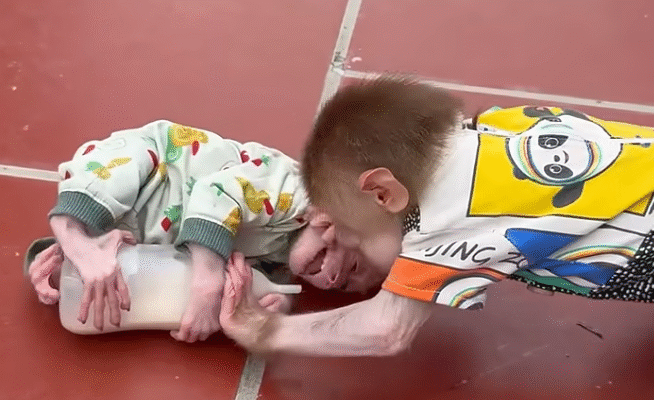The village courtyard was alive with its usual morning cheer. The roosters had crowed, the farmer’s children were chasing each other, and in the center of the yard, two baby monkeys—Bibi and Lala—were already up to their usual antics.
Lala, the younger of the two, had just been given a fresh, warm bottle of milk. Her little eyes sparkled with happiness as she hugged it tightly against her chest. Bibi, older and far more mischievous, noticed immediately. She had already finished her own bottle earlier, but she wasn’t satisfied. Seeing Lala’s bottle filled with milk made her tail twitch with jealousy.
“Give me some,” Bibi seemed to say as she scooted closer, her curious little hands reaching out.

But Lala, protective of her treasure, turned her back and shook her head. Her tiny lips clung to the bottle as if guarding it with all her strength. She wasn’t about to give up her milk so easily.
The caretaker, watching from a distance, chuckled softly. “Oh dear, this is going to be interesting.”
Bibi, however, wasn’t in the mood for laughter. She wanted more milk, and she wanted it now. First, she tried gentle persuasion. She tugged lightly on Lala’s arm, squeaked sweetly, and pointed at the bottle with hopeful eyes. But Lala shook her head again, clutching the bottle tighter.

Then, Bibi tried trickery. She pretended to spot something exciting on the ground. With exaggerated squeals, she pointed at the grass as though a shiny bug or a piece of fruit had appeared. Lala, curious as always, turned her head for just a second—but not long enough for Bibi to snatch the milk. Lala had learned her sister’s tricks.
Frustration built up in Bibi’s little chest. Her hands twitched, her tiny face scrunched, and her eyes narrowed. Finally, with a burst of impatience, Bibi shoved Lala to the ground.
It wasn’t a hard push—just enough to knock her off balance. Lala squeaked in surprise and tumbled onto the soft dirt, the bottle of milk bouncing out of her hands.
The courtyard went silent for a moment. Even the chickens nearby stopped pecking to look.

Bibi pounced on the bottle before Lala could recover. She hugged it like a prize and began drinking greedily, her tail flicking in victory. Milk dribbled down her chin as she gulped, completely ignoring her sister’s indignant squeaks.
Lala sat on the ground, wide-eyed and upset. Her tiny face wrinkled as tears welled up. She let out a high-pitched wail that carried across the yard. The caretaker rushed over at once.
“Bibi!” the caretaker scolded, lifting the greedy little monkey by the arms. “That was not nice. You can’t push your sister down just because you want her milk.”
But Bibi clung stubbornly to the bottle, unwilling to let go. Her lips tightened around the rubber teat as if glued to it. She glanced sideways at Lala, who sniffled and rubbed her eyes, her expression a mix of anger and sadness.
The caretaker sighed and gently took the bottle away from Bibi. “If you can’t share nicely, then neither of you gets it.”
Now both monkeys looked betrayed. Bibi screeched in protest, while Lala sobbed harder. The caretaker shook her head, clearly torn between amusement and exasperation.
After a few moments, she tried again. She gave the bottle back to Lala but held out another smaller cup for Bibi. “See? There’s enough milk for both of you. But you must share.”
At first, Bibi didn’t accept it. She pouted, crossing her arms dramatically, her little tail lashing behind her. But when she saw Lala happily drinking again, her jealousy flared up. Slowly, she reached for the cup.
For a while, both monkeys drank quietly—though Bibi’s eyes never left Lala’s bottle. Every few sips, she scooted closer, as if waiting for another chance to steal it.
But then, something unexpected happened.
Lala, still sniffling from earlier, paused. She looked at her sister’s half-empty cup, then at her own full bottle. Her little brow furrowed in thought. With surprising gentleness, she pushed the bottle toward Bibi.
Bibi froze. Her greedy instincts told her to snatch it, but her sister’s teary eyes softened her heart. Instead of grabbing, she took a small sip and then, in a rare show of kindness, pushed it back.
The caretaker smiled warmly. “That’s better. Sharing makes everyone happy.”
The tension melted away as the two baby monkeys began their familiar game: passing the bottle back and forth, each taking turns to drink. Their earlier quarrel seemed forgotten, replaced with giggles and playful squeaks. At one point, Bibi even held the bottle steady for Lala while she drank, as if to make up for knocking her down earlier.
The villagers who had gathered around the yard chuckled at the sight. “Look at them,” one said. “They fight like children, but they forgive just as quickly.”
“True,” another agreed. “Sometimes they teach us more about family than we teach them.”
Later that afternoon, with their bellies full of milk, the two monkeys curled up together in the hammock. Lala rested her head on Bibi’s shoulder, while Bibi absentmindedly stroked her sister’s tiny fingers. They both drifted off into a peaceful nap, the drama of the morning completely forgotten.
The caretaker shook her head with a smile. “Monkeys are like children—they argue, they cry, they fight, but in the end, love always wins.”
The lesson was simple yet powerful. Bibi had learned (at least for the moment) that pushing and grabbing only caused tears, while sharing brought laughter. Lala, in her innocence, had shown forgiveness and generosity that touched everyone watching.
And so, the little courtyard returned to its rhythm of clucking chickens, children’s laughter, and swaying leaves. The story of how Bibi knocked her sister down over milk would be told again and again by amused villagers. But more importantly, they would remember how quickly the quarrel turned into forgiveness, how two tiny monkeys reminded them that even in moments of jealousy, kindness could always bring hearts back together.



